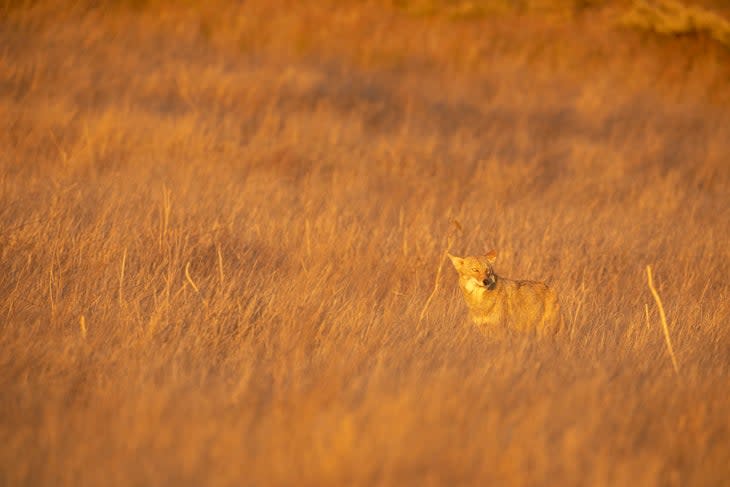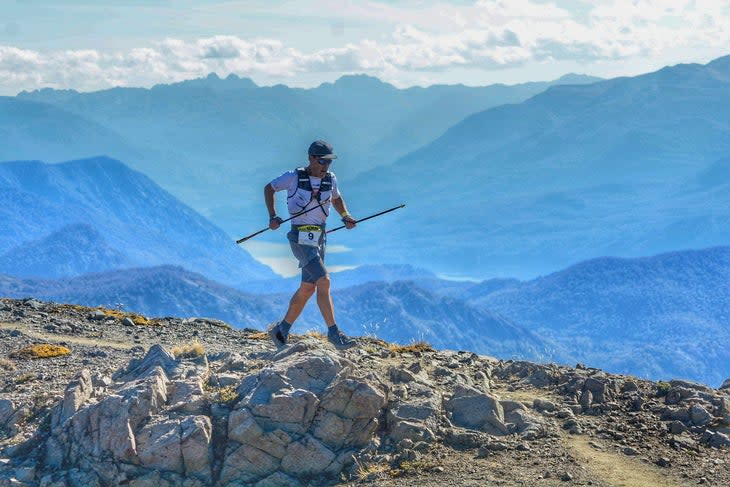Did Ultrarunning Legend Dean Karnazes Really Get Attacked By A Coyote?
This article originally appeared on Trail Runner
At about 3 a.m. on Saturday morning, August 13, ultramarathon icon Dean Karnazes, 59, plodded along by headlamp, alone, 40 miles into the 150-mile Marin Headlands Endurance Race near San Francisco, California's Golden Gate Bridge, when he was hit by something from behind.
Minutes later, stunned and bloody-lipped, with glazed eyes and an unsettling grin--Karnazes pulled out his phone and recorded the following 37-second video, which has since gone viral:
"I just had something rather terrifying happen," Karnazes says. "I'm out on a 150-mile trail run, and I got attacked by a coyote. That was a first. Knocked me over. Thankfully I was running with poles, so I whacked it and it ran away." He then looks at the camera, a bit dazed. "Kinda brutal."
With a short laugh, he sniffles blood and looks around. "Not sure what I'm going to do but, I guess I gotta keep going or else it'll probably come back for me." Another chuckle.
Once posted on social media, comments started to flood in. Responses were wide-ranging, everything from supportive ("Maniac! Be safe." "You are a Greek warrior!"), to medical advice ("Get your rabies shot!" "Tetanus shot, immediately!"). Others thought it apocryphal: ("It didn't attack him. He lied." "Coyotes don't attack humans. Probably some kind of cat." "That's fake blood.")
Coyote Attack or Fall?
To be sure, resident coyotes of California's Golden Gate Recreation Area have become increasingly habituated to humans, but the odds of a coyote pouncing on a human are exceedingly rare. Park officials publicly addressed the supposed attack, saying in a Tweet: "We want to emphasize that the injuries shown were caused by a fall. The coyote did not bite the individual involved in this encounter."
RELATED: Everything Trail Runners Need To Know About Wildlife Safety
Trail Runner reached out directly to Karnazes, to get more of the story.
"As I’ve said all along--including in my report to the park ranger--the coyote knocked me from behind trying to snatch the energy bar I was eating. It didn’t jump on my face and I’ve never claimed it did."
Wildlife attacks on trail runners are rare, but they do happen. However, coyotes are hardly a common culprit. There are only two recorded incidents of coyotes actually killing humans, worldwide, one of whom was a three-year-old child.

But in recent years, there has been an uptick in human encounters with coyotes, namely in zones called the "suburban-wildland interface," where human development encroaches on undeveloped wild space. According to Outforia, a Norway-based outdoor research website, California experiences the second-highest rate of wildlife attacks on humans in the U.S. after Texas, with 299 fatal attacks between 1999-2019, based on CDC data.
Feeding Coyotes Only Makes Things Worse
Karnazes's encounter with the coyote happened in an area on the northwest side of the Golden Gate bridge, a notorious spot for people feeding local coyotes. "The coyote didn’t want me, it wanted the food," said Karnazes. "In hindsight, it's really not that shocking at all."
Following the incident, he continued posting updates on Facebook: "As I've witnessed firsthand, people (mostly tourists) have been feeding wild coyotes in the Marin Headlands area of California. This has got to stop. If you see someone feeding a coyote, please say something. The local rangers are doing the best job they can, but we trail runners are out in these areas more than anyone."
Dan Flores is a historian from New Mexico and author of ten books, including the New York Times bestseller, Coyote America, and told us that such coyote behavior sounds unusual.
"My best guess would be that he got too close to a female coyote whose summer pups are still young enough to inspire a strong protective response,” says Flores. “August would be too late in Marin for pups to still be around a den, but this summer’s still-young pups are with their parents and packs right now."
RELATED: Dean Karnazes Is Still Running Inspired
Like us, coyotes are highly individualistic. A hungry one could easily be drawn by the sound of squeaking shoes, thinking it a mouse, shares Flores. He referenced a recent story of a coyote stalking someone because his boots were squeaking in the snow. Running itself may invite a chase, too, "although, as a lifetime runner--most of it in coyote country--nothing remotely like that has ever happened to me," says Flores.
Wild Animals Just Aren't That Interested In Us
Peter Alagona is a trail runner, environmental historian at UC Santa Barbara, and author of The Accidental Ecosystem: People and Wildlife in American Cities. He reminds us that even the scariest wild animals act, for the most part, fairly passively toward people.
"The vast majority of so-called wildlife 'attacks' involve animals that are sick or injured, have come to associate humans with food, or are caught by surprise and act defensively," says Alagona. "Predatory attacks, except by a few species - like crocodiles and tigers - are extraordinarily rare. If we don’t feed wild animals, give them space, and respect them, they will return the favor by providing us with ecological services, thrilling moments, and profound insights."
But that doesn't mean we, as trail runners, ought to let our guard down while in wild spaces.
"Trail runners run a marginally higher risk than most other people because we tend to move quickly and quietly, and thus can find ourselves in the unfortunate predicament of surprising an animal, which may respond by acting defensively," says Alagona.
This was not the ultrarunning icon's first run-in with wildlife. "I've been attacked by a shark and now a coyote," Karnazes tweeted recently. "Both incidents were terrifying." #animalattack #survivalmode

An "Attack" Is More Bite Than Bark
It appears clear that the legendary ultrarunner was approached by an overly-curious coyote habituated to overly-generous humans, perhaps protecting her young or perhaps interested in what food he had to share. Who knows.
But, technically, the coyote did not "attack" Karnazes.
According to a scientific paper on wildlife attacks on the humans, the very definition of an "attack" can get overused and under-scrutinized in public discourse:
"We define a coyote attack as an incident between a coyote and a person that results in a bite to the victim. We recognize that this conservative definition may exclude aggressive incidents that did not result in a bite, but our experience is that non-bite incidents are difficult to interpret, particularly when reported by a general public not familiar with coyote behavior. In these instances, it is difficult to determine the intent of the coyote and the true threat to the human involved. By only classifying incidents resulting in a bite to the victim, we feel that we are using the least subjective interpretation of events regarding the most extreme type of conflict between coyotes and humans."
The coyote did not bite Karnazes, but in his defense, he never said it did. Karnazes did, however, use the word "attack," in his recounting, when the only thing being technically "attacked" here was his unwrapped energy bar, which may have precipitated the incident.
When asked what kind of energy bar, he declined to comment. He was too busy running.
For exclusive access to all of our fitness, gear, adventure, and travel stories, plus discounts on trips, events, and gear, sign up for Outside+ today.

